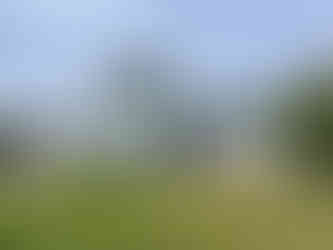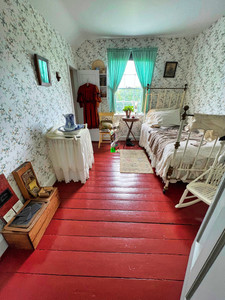PEI and the Gaspé Peninsula
- dougsmith51
- Jul 10, 2022
- 6 min read

Newfoundland was the farthest east we’d go in our Canadian travels. After returning to Nova Scotia on the ferry and overnighting on Cape Breton Island, we left the next morning for the six-hour drive west to Prince Edward Island, the smallest Canadian province.
We’d last been to PEI in 1993 and on that trip we’d had to take a ferry from New Brunswick. In the intervening years they’ve built the 8-mile-long Confederation Bridge from the mainland to the island.

During our travels we’d prepared for our visit by listening to audiobooks of the first two Anne of Green Gables series which take place on PEI. The island was largely agricultural when the books were written and that has not changed. Driving across the island to our campground, we passed many small family farms and a patchwork of fields growing many different crops.
We camped at Cavendish campground in Prince Edward Island National Park along the north shore, arriving on July 1st, Canada Day (the Canadian equivalent of the Fourth of July). We joined a local celebration (and fireworks) at the nearby town of North Rustico. Lots of families and excited kids, including a little girl decked out in Canada headband and glow necklaces, and a little boy who gave a running commentary (“Wow!” “Mom, they’re coming right at us!”) during the fireworks.
Our first full day on the island, we walked to the campground beach, then retreated as a rainstorm came dashing over the horizon. We’d noticed on the day of our arrival that the base plate bolted on to the Fit (that we attach to the towbars behind the Ciaowagen) was quite loose, so we arranged to have it looked at by a nearby tire store. They tried tightening it but ran out of time. We would need to have it worked on somewhere else sometime soon. They also told us one of our stabilizer rods had broken and the two front tires would need to be replaced soon. We wondered if the condition of the Newfoundland roads had something to do with the damages. In all, we've had lots of Fittata work this year (e.g., our recent transmission rebuild) but that’s the consequence of all our road-tripping!
The Cavendish area, where we were camping, is obviously a big tourist draw with lots of beaches, cottage and hotel rentals, shops, water parks, and so forth. It reminded us a New Jersey shore town, although not quite so crowded. The PEI agriculture reminded us of southern NJ as well.
The next day, we traveled to the nearby Green Gables National Heritage Site, which preserves the farmhouse on which Lucy Maud Montgomery based her “Anne of…” stories. The restored farmhouse sported a green roof and of course, green gables! The house was a fairly true rendition of the house described in the book complete with furnishings and personal items authentic to the era.
It is not the house that Montgomery grew up in ( she raised by her grandparents on the island) but was the home of nearby cousins with whom she was very close.
The site included a COVID-safe Anne Shirley re-enactor who would answer questions from visitors. She interacted easily with visitors of all ages, and always used Anne's particularly ebullient language and mannerisms.

We learned that the Green Gable books are particularly popular in Japan and indeed we saw many Asian visitors at the site. We found out from one of the rangers that an English-language copy of the book found its way to Japan during WWII, and although having such a book was a punishable offense, a Japanese women worked secretly to translate the book. After the war, it became a widely read; in fact for a while it was required reading in the Japanese school system!
We also took the 1 km hike through the Haunted Woods (named by Anne in her first book) as well as down Lovers Lane (a carriage path covered by overarching trees).

In the afternoon, we got our eBikes out of the car for the first time in a few weeks and headed out on one of the extensive bike paths lining the northern PEI shore. This area features a lot of beaches and red sandstone cliffs.

Unfortunately, a few miles into our ride we looked back and saw a line of ominous clouds approaching. Jeannette was very glad she did not have a bike basket carrying a little dog named Toto!

We turned around and managed to find a beach shelter before the rain started in earnest. We were not alone. There were a group of young Pakistani men who had to quickly take down their grill and postpone their supper. They offered the two remaining chicken wings they had cooked to us, but we demurred assuring them "It's the thought that counts!" We then sheltered from the wind and rain in a small space with a French Canadian family and shared our belief that a bad day at the beach was better than a good day at the office. Laughing, they agreed.

We returned in the evening to see the sunset on the shing waters and red rocks.

Before leaving PEI, we knew we had to sample one of the island's most famous products: mussels. We made reservations at a restaurant near the campground known for its seafood. We noticed the family at the next table had ordered mussels and one of their sons was trying them for the first time. Jeannette asked his opinion about whether we should order them or not. You can see the result below - they were delicious!

Over the next two days, we undertook one of the longer drives of our trip (600+ miles) to the Gaspé Peninsula at the mouth of the St. Lawrence River. We drove the Ciaowagen and the Fittata separately due to the tow plate issues. The drive took us along beautiful shorelines, into Quebec, northward to almost the same latitude we'd been in Newfoundland, and back to the Eastern time zone.
Our destination was Forillon National Park at the end of the peninsula, a place of dramatic cliffs rising from the sea. We staying in the des-Rosiers ("Rosebush") campground in the national park, and walked down to the beach the evening of our arrival. The “beach” was covered with smooth, flat, rounded stones that made a musical sound as the surf washed over them. We could see the end of the peninsula in the distance.

Walking along the beach cliffs we saw some interesting lifting and folding of sedimentary rocks.

Strewn along the beach were pieces of local lobsters that had washed ashore. They were huge!
The next day was rainy and we drove to the town of Gaspé, where we were finally able to get both the tow hitch plate and the suspension stabilizer rod fixed. They did not have the tire sizes we needed, so those would need to be replaced when we reached Quebec City. Canadian Tire (a nationwide chain) did the work, and we were very impressed with their customer service and their relatively low prices (at least compared to Virginia).
Since we were already halfway there, we drove to the town of Percé to see the famous Percé Rock which lies just offshore. During low tide you can walk out to and around the rock but we arrived at the wrong time. We looked for a different vantage point to take a photo that would show the arch at one end, but the town only offered super-expensive parking options so we opted out.

Back in Forillon, the weather was finally clearing so we checked out some potential hikes or bike rides for the next day. We also saw stopped at one overlook and saw humpback whales spouting in the distance (too distant to photograph, unfortunately).
We stopped to hike to La Chute (a small but pretty waterfall)...

...and drove to Cape Bon Ami beyond our campground for more dramatic beach views, tilted sedimentary rocks, and some interesting moss-covered, dripping rocks.

The next day was beautiful and we headed out with our bikes. We first rode from our campground to Cap-des-Rosiers lighthouse, the tallest in Canada at 112 feet, then returned to the campground for lunch.
After lunch, we drove to the other side of the Forillon peninsula (it’s only 5-6 miles wide at this point) and back into the national park. At the road's end, we mounted our bikes and rode on a gravel path to the very end of the peninsula. The word Gaspé is taken from the language of the Mi’kmaq (the indigenous people that live in eastern Canada) and means “Land’s End.” When you stand on the peninsula’s tip, you do feel like you are at the end of the world since the nearest lands (Newfoundland to the east, Labrador to the north) are over the horizon. The point is also the end of the International Appalachian Trail, which extends from the original AT's end at Mount Katahdin in Maine.
Cape Gaspé lighthouse sits on the point. It’s not very tall, but since it’s up so high on the cliff it can be seen far out in the Gulf of St. Lawrence.

We also found a set of Parks Canada red chairs and sat down to enjoy the view.

We rode back to the parking lot, then drove to the Penouille district of Forillon National Park where a sand spit thrusts out into the bay. We hiked for about three miles across a boardwalk and then through a “taiga” forest of black spruce and lichen – a rare environment that’s protected as part of the park.

The next morning, after a last visit to the pebble beach near the campground, with repairs made we could once again with attach the Fittata to the back of the Ciaowagen. We began the two-day drive along the top of the peninsula and the St. Lawrence River to Quebec City. More about our time in Quebec and Montreal in our next blog post.










































Kommentare